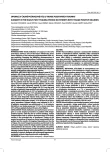Surgery in the early post-trauma period in patients with triage positive injuries
Authors:
František Vyhnánek 1; Jakub Štefka 2; David Jirava 2; Martin Očadlík 2; Pavel Douša 3; Marek Laboš 4; Michal Fric 5
Authors‘ workplace:
Traumatologické centrum FNKV, Praha
Traumatology Centre, FNKV, Prague, Czech Republic
1; Chirurgická klinika 3. LF UK, Praha
Department of Surgery, Third Faculty of Medicine, Charles University, Prague, Czech Republic
2; Ortopedicko-traumatologická klinika 3. LF UK, Praha
Department of Orthopaedics and Traumatology, Third Faculty of Medicine, Charles University, Prague, Czech Republic
3; Radiodiagnostická klinika 3. LF UK , Praha
Department of Radiodiagnostics, Third Faculty of Medicine, Charles University, Prague, Czech Republic
4; Klinika anesteziologie a resuscitace
Department Anaesthesiology and Resuscitation, Third Faculty of Medicine, Charles University, Prague, Czech Republic
5
Published in:
Úraz chir. 24., 2016, č.3
Overview
Introduction:
Timely indication of surgery in the early post-injury period is one of the factors influencing treatment outcomes of the seriously polytraumatized with triage positivity. Stopping the bleeding, decompression of the body cavities and prevention of continuous contamination are the primary aims of emergency surgical procedures in patients with blunt and penetrating injuries. Significant decrease of the lethality in patients with triage-positive injuries is associated with the use of damage-control surgeries, especially in patients with chest, abdominal and pelvic trauma, and patients with extremity injuries.
Material, methods, results:
We analysed a total of 1735 patients with triage-positive injuries admitted to our Traumatology Centre who underwent an emergency or delayed surgical procedure between 2008 and 2014. In this group there were 1334 males and 401 females. A total of 1447 (83 %) patients had the ISS<16 upon admission. In most cases, they were patients with primary injuries – 82.9 %. The injuries were most frequently caused by traffic collisions (51 %), followed by falls from height (36 %). From the total number of patients, triage positivity was observed in 45 % of patients with polytrauma, in 33 % of patients with an isolated craniocerebral injury, in 15 % of patients with associated injuries, and in 7 % of patients with a monotrauma. Head was the most frequently injured body region (79 %), followed with the chest (49 %) and extremities (41 %). A total of 1320 patients underwent surgery, 72 % of them as an emergency procedure. Delayed surgery was indicated in 24 % of patients, reoperation was performed in 4 % of patients. Mortality in our study group was 17.9 %, where more than 65 % of these patients had an ISS score 40 or higher.
Conclusion:
Timely indication and performance of emergent or acute surgical procedure in patients with triage-positive injuries, with the aim to control bleeding, reduce contamination and to achieve decompression of the body cavities is the principal aim of treatment. Timing of the surgical procedures is based on clinical examination of the patient and the results of imaging. Depending on the site of injury, the most frequent procedures performed in the early post-injury period in triage-positive patients include osteosynthesis of fractures of the extremities, the pelvis, craniotomy and laparotomy. Staged surgical management (damage-control surgery and orthopaedics) is a treatment method of choice in patients with prolonged hypotension, metabolic acidosis, hypothermia and coagulopathy.
Keywords:
Triage-positive injuries, emergency – delayed surgery.
Sources
1. BOSCHIN, M., VORDEMVENNE, T. Firstaid management of multiple trauma: in-hospital trauma care. Anaesthesiol Intensiv med Not fall med Schmerzther. 2012, 47, 716–723. ISSN 0939-2661
2. DUCHESNE, JC., KIMONIS, K., MARR, AB. et al. Damage control resuscitation in combination with damage control laparotomy: a survival advantage. J Trauma. 2010, 69, 46–52. ISSN 0022-5282
3. GEERAEDTS, LM., KAASJAGER, HA., van VUGT, AB. et al. Exsanguination in trauma: A review of diagnostics and treatment options. Injury. 2009, 40, 11–20. ISSN 0020-1383
4. JAUNOO, SS., HARJI, DP. Damage control surgery. Inter J Surg. 2009, 7, 110–113. ISSN 1743-9159
5. LICHTE, P., KOBBE, PH., DOMBROSKI, D. et al. Damage control orthopedics: current evidence. Curr Opion Crit Care. 2012, 18 , 647–650. ISSN 1070-5295
6. MAXWELL, CA., MION, LC., MUKHERJEE, K. et al. Preinjury physical frailty and cognitive im pair mentamonggeriatric trauma patients determine post in jury function al recovery and survival. J Trauma Acute Care Surg. 2016, 80, 195–203. ISSN 2163-0755
7. RIXEN, D., STEINHAUSEN, E., DAHMEN, J. et al. S3 - guideline on treatment of polytrauma/severe injuries. Initial surgical phase: significance-possibilities – difficulties? Unfallchirurg. 2012, 115, 22–29. ISSN 0177-5537
8. STAHEL, Ph.F., SMITH, WR., MOORE, EE. Current trends in resuscitation strategy for multi plyin juried patient. Injury. 2009, 40S4, 527–535. ISSN 0020-1383
9. VYHNÁNEK, F. Současný postup u poranění jater. Úraz chir. 2012, 20, 36–34. ISSN 1211-7080
10. WURMB, T., BALLING, H., FRÜHWALD, P. et al. Polytrauma management in a period of chase: time analysis of new strategies for emeegrency room treatment. Unfallchirurg. 2009, 112, 390–399. ISSN 0177-5537
Labels
Surgery Traumatology Trauma surgeryArticle was published in
Trauma Surgery

2016 Issue 3
- Metamizole at a Glance and in Practice – Effective Non-Opioid Analgesic for All Ages
- Metamizole vs. Tramadol in Postoperative Analgesia
- Safety and Tolerance of Metamizole in Postoperative Analgesia in Children
- Metamizole in perioperative treatment in children under 14 years – results of a questionnaire survey from practice
- Obstacle Called Vasospasm: Which Solution Is Most Effective in Microsurgery and How to Pharmacologically Assist It?
Most read in this issue
- Comparsion of treatment methods and complitacions in pilon fractures of the tibia
- Closed reduction and intramedullary fixation using Kirchner wires and plate osteosynthesis in the treatment of fractures of distal end of fifth metacarpal bone
- Surgery in the early post-trauma period in patients with triage positive injuries
- Injuries of the Diaphragm
